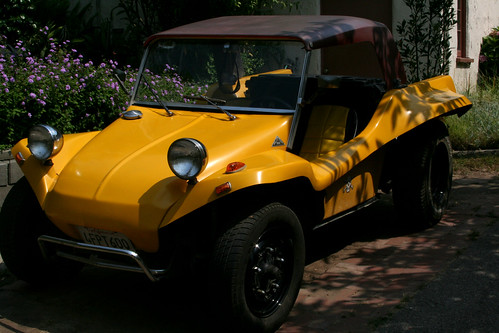
Just as each project breaks down into smaller parts, the car itself breaks down into systems and major components. Here's what I consider the major parts and systems of an automobile.
Frame
Body
Suspension System
Engine and Drive Train
Engine Cooling System
Engine Electrical System
Body Electrical System
Braking System
Fuel System
Guidance System
You have to have all these things to have a safe, street-legal vehicle, whether it be car, truck, or motorcycle. In a dune buggy, you can get by with the bare minimum of most of these components. You may have noticed some things missing which you consider necessary on your own car, such as a heating and air conditioning system, or a sound system. You can add these to a dune buggy, but for a vehicle which is designed to go off road, as well as on the highway, it is best to keep things to a minimum. Extra weight and delicate electronics are not necessarily well suited to climbing hills or blasting through mud puddles in the rain. Some people feel that they can't do without such luxuries and add heaters, stereos, side-curtains with plastic windows, carpets and such to their buggies. I would be reluctant to expose that sort of car to mud puddles in the rain, or extremely dusty conditions, but some people do so and take whatever consequences that arise.
The above major parts and systems each break down into smaller sub-systems.
You would think that the frame is just the frame, but there are main frame members and braces and cross members on some frames. The Volkswagen frame started out at the factory as a welded one-piece floor pan, but over the years, parts of that floor pan are prone to rusting, so sometimes it is necessary to remove the floor parts and weld in new ones. On some VW-based dune buggies, including mine, these pans are shortened by a little over a foot, resulting in a smaller, lighter, more agile, but less roomy car.
The body of a car can include doors, windows, hood, trunk, top, and seats. In that case there is a break down into interior and exterior body parts. In my dune buggy, there is the body, a windshield and two seats. That's pretty much it. The body is in three pieces, the main body which includes the fenders and the rear deck, the front cowling, and the dashboard. There is also an optional roof which isn't ever necessary, though it makes the car much more comfortable by keeping the sun and the rain off your head. The windshield in my dune buggy is a separate assembly and bolts to the main body at the sides. There are no carpets, no heating systems, no air conditioning systems, no cupholders, no center consoles, no arm rests, no doors, no side or rear windows, and no box for your gloves.
What I like most about my dune buggy is how very simple it is. I tell people that it consists of the fewest parts you can put together and still have something you can call a car. The other systems outlined above break down into more complicated parts. I will write about those in future blogs. For today, it's enough to have looked at how you can break down a car into parts and systems to make it more easily understandable and less overwhelming. Every time I get out the tools and work on my cars, I learn something new. That's the most wonderful part of building your own cars, they teach you things about themselves and about life in general if you're willing to listen.




No comments:
Post a Comment